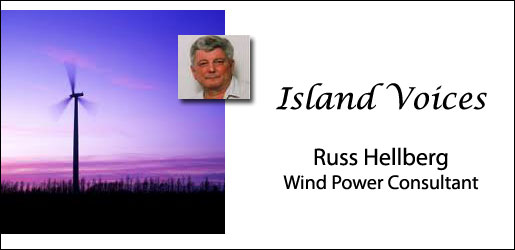Russ Hellberg October 2007
Current Article ∙ Archive ∙ Back to Island Voices
Change is in the Air
Wind power keeps improving in big and small ways. Advances in technology and soaring energy costs are making wind power a clean and viable option for big and small energy producers everywhere.
There’s growing interest in wind right across this country. From major power producers looking for cleaner ways to produce energy for the grid to inventive companies searching for alternative ways to power their plants – even down to the individual who wants to live off-grid – it’s the people who believe in wind who power it.
Belief in wind is driving the advances.
Wind turbine technology.
The windmill has been used for millennia to grind grain. In the decades leading up to the 1930s, the wind turbine was used to generate electricity. Since the 1970s wind power, and the technology behind the modern turbine, has undergone a revolution. The first modern turbines were larger than those of the 1930s and were grouped together to form wind farms for the purpose of generating electricity. First used in Denmark and California in the 1970s, the average output of a wind turbine back then was 100 kW. Today, that output is typically 20 times greater.
Today’s turbines are far more efficient machines. They sit higher up in the air affording them access to better wind resources and fewer obstacles. The materials used to build the blades are stronger and lighter, so turbines can be built bigger and cover a greater area as they spin, generating far more electricity with every sweep.
Offshore.
In other parts of Europe, a smaller inventory of onshore sites has led to the development of offshore wind. Putting turbines offshore offers producers the opportunity of a stronger and steadier wind resource. As offshore sites are more expensive to build, turbines must be larger and more efficient. Bigger wind turbines are being developed in Europe to make the most efficient use of their offshore wind resource.
In Canada, we are mainly focused on our onshore resource at this time, but some offshore projects are being pursued.
Small wind. Small turbines.
Small wind turbines (300 kW or less and generally referred to as “small wind”) give farmers or businesses a chance to generate electricity for their own purposes with one or two turbines located on their property. Small wind allows users to reduce their dependence on the grid and gives them an effective way to produce electricity themselves. Small wind turbines are much smaller – think 15 meters tall instead of the 90 meter models associated with wind farms. And small wind can be used for something as modest as supplementing a percentage of a home or business’ energy use to powering a small community of several houses. The applications of small wind are limitless.
Big advances. Bigger turbines.
Wind turbines and the farms that house them get bigger every year. The increased size of turbines has meant they can produce more energy more efficiently, and this drives down cost. In fact, the cost of wind-generated electricity has dropped more than 80% in the last 20 years and further declines are expected. Five years ago, wind turbines in Canada generated 600 kW; today the average turbine generates 1.5 MW. That’s nearly a three-fold increase in output in just 5 years. Today 3 MW turbines are coming on line and in Europe, 5 MW prototypes are being designed – the technical evolution carries on.
Canadian Wind Energy Association
Powering Canada’s future naturally
Toll Free: 1.800.922.6932
T: 613.234.8716 / F: 613.234.5642
www.canwea.ca
Nomis is planning on 1.5 to 2 MW turbines for its Nahwitti wind Farm on North Vancouver Island but is looking hard at the new machines in development such as the 2.5 and 3 MW direct drive models as they are more efficient and have lower operating costs.
www.nomispowercorp.com


